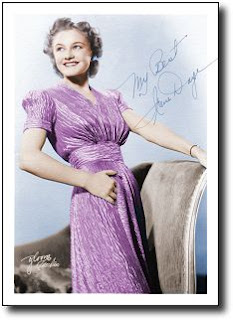The Perseverence Of Irene Daye
One of the things I’ve learned during six years of doing this is that even performers who don’t reach big stardom can still have fascinating life stories. A good example is big-band songbird Irene Daye, who was never a huge name but still managed to be the solo vocalist on one of the biggest hits of the era. But wait, there’s more. She then married the band’s trumpeter and retired (at age 23) to raise a family, only to be forced to resume her career a few years later because her husband had abruptly died. But she persevered, again becoming the star vocalist for a well-known band — and eventually even married the bandleader, before once again retiring from performing.
Irene Daye was still in high school in Lawrence, Massachusetts, in the mid-1930s when she began her professional career by landing a job singing for the Jan Murphy Orchestra. Within a couple of years she had managed to work her way into a spot as the lead female vocalist for one of the biggest of the big bands — Gene Krupa’s. She stayed with him until 1941, long enough to make dozens of records, none bigger than the last one she recorded for him — “Drum Boogie” — which was so popular that it was even featured in the Gary Cooper movie, Ball Of Fire. (According to IMDB, Barbara Stanwick’s singing was dubbed by Martha Tilton, but several other sources name Irene Daye so let’s go with that.)
It was also about then that trumpeter Corky Cornelius won Daye’s heart and she retired from performing to become a wife and mother. (Krupa replaced her with Anita O’Day, who subsequently enjoyed a long and celebrated career.) Unfortunately, Cornelius died within a couple of years and Daye had to go back to work, but she wasted no time latching on with Charlie Spivak and his orchestra. She was a solid part of the group for several years before finally marrying the bandleader in 1950, and again retiring from active performing. She eventually took over the business side of his career, but died at just age 53 in 1971...


No comments:
Post a Comment